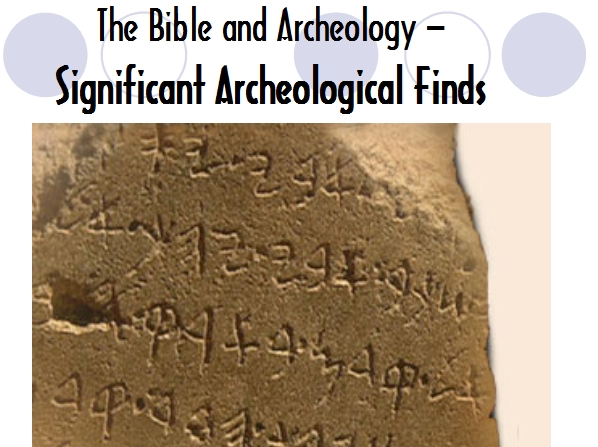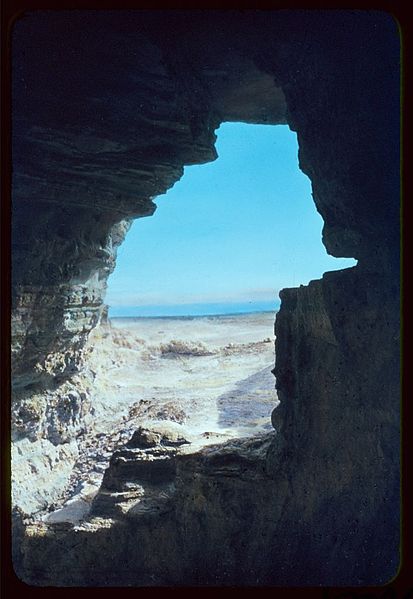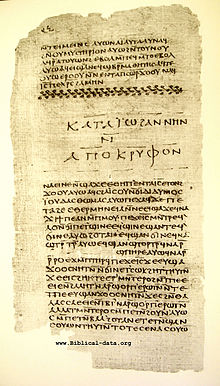|
DPS Biblical
Archeology Study Outline
7. Archeological Finds that Preserve the Integrity of
the Bible
|

Download: Teacher's Script: (PDF)
(Word) |
Handout: (PDF) (Word) |
PowerPoint
Overview
a. The Dead-Sea Scrolls
b. The Nag Hammadi
Library
Discussion Questions
a. The Dead Sea Scrolls
 The
Dead Sea scrolls consist of roughly 1000 documents, including texts from
the Hebrew Bible, discovered between 1947 and 1979 in eleven caves in
and around the Wadi Qumran (near the ruins of the ancient settlement of
Khirbet Qumran, on the northwest shore of the Dead Sea) in Israel. The
texts are of great religious and historical significance, as they
include practically the only known surviving copies of Biblical
documents made before 100 AD, and preserve evidence of considerable
diversity of belief and practice within late Second Temple Judaism. The
Dead Sea scrolls consist of roughly 1000 documents, including texts from
the Hebrew Bible, discovered between 1947 and 1979 in eleven caves in
and around the Wadi Qumran (near the ruins of the ancient settlement of
Khirbet Qumran, on the northwest shore of the Dead Sea) in Israel. The
texts are of great religious and historical significance, as they
include practically the only known surviving copies of Biblical
documents made before 100 AD, and preserve evidence of considerable
diversity of belief and practice within late Second Temple Judaism.
The scrolls were found in 11 caves,
ranging in distance of 125m (Cave 4) to about 1000m (Cave 1) from the
settlement at Qumran, located 1km off the northwest shore of the Dead
Sea. None of them were found at the actual settlement. It is generally
accepted that a Bedouin goat- or sheep-herder by the name of Mohammed
Ahmed el-Hamed (nicknamed edh-Dhib, "the wolf") made the first discovery
toward the beginning of 1947.
In the most commonly told story the
shepherd threw a rock into a cave in an attempt to drive out a missing
animal under his care. The shattering sound of pottery drew him into the
cave, where he found several ancient jars containing scrolls wrapped in
linen. Another theory was that two young boys were looking for a lost
goat and came upon some of them.
The significance of the scrolls relates
in a large part to field of textual criticism. Before the discovery of
the Dead Sea Scrolls, the oldest Hebrew manuscripts of the Bible were
Masoretic texts dating to 9th century. The biblical manuscripts found
among the Dead Sea Scrolls push that date back to the 2nd century BC.
Before the discovery, the oldest Greek manuscripts such as Codex
Vaticanus and Codex Sinaiticus were the earliest extant versions of
biblical manuscripts. Although a few of the biblical manuscripts found
at Qumran differ significantly from the Masoretic text, most do not. The
scrolls thus provide new variants and the ability to be more confident
of those readings where the Dead Sea manuscripts agree with the
Masoretic text or with the early Greek manuscripts.
Further, the sectarian texts among the
Dead Sea Scrolls, most of which were previously unknown, offer new light
on one form of Judaism practiced during the Second Temple period.
Books: Genesis, Exodus, Leviticus,
Numbers, Deuteronomy, 1&2 Samuel, Job, Isaiah, Jeremiah, Ezekiel,
Psalms, Minor Prophets, Daniel
Conclusion:
the greatest impact that the scrolls have provided is that they confirm
a reliable preservation of the Old Testament text over an extended
period of time. By extension an argument could be made that the same
claim can likely be made for the preservation of the New Testament
writings.
b. The Nag Hammadi Library

The Nag Hammadi library (popularly known as The Gnostic Gospels) is a
collection of early Christian Gnostic texts discovered near the town of
Nag Hammâdi in 1945. That year, twelve leather-bound papyrus codices
buried in a sealed jar were found by a local peasant named Mohammed Ali
Samman. The writings in these codices comprised fifty-two mostly Gnostic
tractates (treatises), but they also include three works belonging to
the Corpus Hermeticum and a partial translation / alteration of Plato’s
Republic. In his "Introduction" to The Nag Hammadi Library in English,
James Robinson suggests that these codices may have belonged to a nearby
Pachomian monastery, and were buried after Bishop Athanasius condemned
the uncritical use of non-canonical books in his Festal Letter of 367
AD.
The contents of the codices were written in Coptic, though the works
were probably all translations from Greek. The best-known of these works
is probably the Gospel of Thomas, of which the Nag Hammadi codices
contain the only complete text.
Case Study from the Nag Hammadi
Library:
The Gospel of Thomas as compared
to the New Testament Canon
Click
here for a full text version of the Gospel of Thomas in
English
http://gnosis.org/naghamm/gthlamb.html
The Gospel of Thomas may have been excluded from the canon of the New
Testament because it was believed not to have been written close to the
time of Jesus [not to have been written by apostolic authority or was
forged in Thomas' name not to have been used by multiple churches over a
wide geographic range to be heretical or unorthodox].
The Gospel of
Thomas does not refer to Jesus as "Christ" or "Lord," as the New
Testament does, but does call him "Jesus," and "Son of Man," which are
concurrent with the canonical Gospels, The Gospel of Thomas also lacks
any mention of Jesus' birth, baptism, miracles, travels, death, and
resurrection. However, over half of the sayings in Thomas are similar to
sayings and parables found in the canonical gospels.
The Gospel of
Thomas does not list the canonical twelve apostles and it does not use
either this expression or the terms "the twelve" or "the twelve
disciples. Although here Mary (presumably Mary Magdalene) and Salome
are mentioned among the disciples, the canonical gospels and Acts make a
distinction between an inner group of twelve male disciples, with
varying lists of names, and a larger group of disciples, among which
there may well have been women.
Thomas 8 SV
8. And Jesus
said, "The person is like a wise fisherman who cast his net into the sea
and drew it up from the sea full of little fish. Among them the wise
fisherman discovered a fine large fish. He threw all the little fish
back into the sea, and easily chose the large fish. Anyone here with two
good ears had better listen!" with Matthew 13:47–50 NIV:
47"Once again, the kingdom of heaven is like a net that was let down
into the lake and caught all kinds of fish. 48When it was full, the
fishermen pulled it up on the shore. Then they sat down and collected
the good fish in baskets, but threw the bad away. 49This is how it will
be at the end of the age. The angels will come and separate the wicked
from the righteous 50and throw them into the fiery furnace, where there
will be weeping and gnashing of teeth."
Note that Thomas makes a distinction between large and small fish,
whereas Matthew makes a distinction between good and bad fish.
Furthermore, Thomas' version has only one fish remaining, whereas
Matthew's version implies many good fish remaining. The manner in which
each Gospel concludes the parable is instructive. Thomas' version
invites the reader to draw their own conclusions as to the
interpretation of the saying, whereas Matthew provides an explanation
connecting the text to an apocalyptic end of the age
Another example is the parable of the lost sheep, which is paralleled by
Matthew, Luke, John, and Thomas.
This is the parable of the lost sheep in Matthew 18:12–14 NIV
12"What do you think? If a man owns a hundred sheep, and one of them
wanders away, will he not leave the ninety-nine on the hills and go to
look for the one that wandered off? 13And if he finds it, I tell you the
truth, he is happier about that one sheep than about the ninety-nine
that did not wander off. 14In the same way your Father in heaven is not
willing that any of these little ones should be lost."
This is the parable of the lost sheep in Luke 15: 3–7 NIV
3Then Jesus told them this parable: 4"Suppose one of you has a hundred
sheep and loses one of them. Does he not leave the ninety-nine in the
open country and go after the lost sheep until he finds it? 5And when he
finds it, he joyfully puts it on his shoulders 6and goes home. Then he
calls his friends and neighbors together and says, 'Rejoice with me; I
have found my lost sheep.' 7I tell you that in the same way there will
be more rejoicing in heaven over one sinner who repents than over
ninety-nine righteous persons who do not need to repent."
This is the parable of the lost sheep in Thomas 107 SV
107. Jesus said, "The kingdom is like a shepherd who had a hundred
sheep. One of them, the largest, went astray. He left the ninety-nine
and looked for the one until he found it. After he had toiled, he said
to the sheep, I love you more than the ninety-nine."
Other parallels include...
Luke 12:16–20 parallels Thomas 63.
Matthew 5:14 parallels Thomas 32.
Matthew 5:15 parallels Thomas 33.
Matthew 10:16 parallels Thomas 39.
Matthew 10:37 parallels Thomas 55 and 101
Matthew 10:27b parallels Thomas 33a.
Matthew 10:34–36 parallels Thomas 16.
Matthew 10:26 parallels Thomas 5b.
Matthew 15:11 parallels Thomas 14.
Matthew 15:14 parallels Thomas 34.
Matthew 22:19–21 parallels Thomas 100.
Click
here for a full text version of the Gospel of Thomas in
English
http://gnosis.org/naghamm/gthlamb.html
Discussion Questions:
In your opinion, can the texts of the Dead Sea scrolls
be used to show that the ancient process of text preservation (oral
transmission or copying scrolls by hand) is largely reliable?
Are the documents from the Nag Hammadi Library beneficial to the
Christian literature? Or should they be banned as heretical?
Can any credence be given to extra-canonical writings, such as the
Gospel of Thomas? Are they useful to read? Do they inform our faith?
Do they shed more light on the historical Jesus?
|